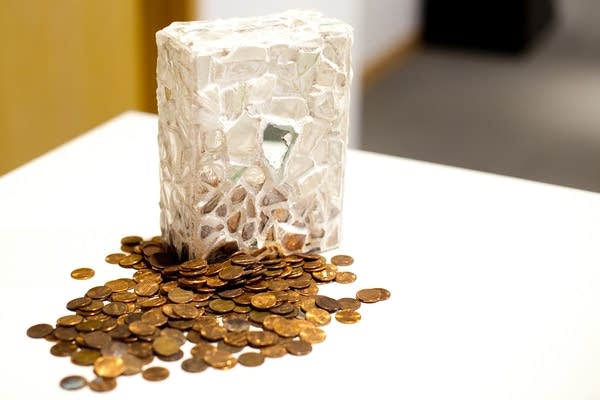The tzedakah tradition: Making the world a better place through giving

Go Deeper.
Create an account or log in to save stories.
Like this?
Thanks for liking this story! We have added it to a list of your favorite stories.
As a girl, Robyn Awend was obsessed with the little blue and white box always on display in her household, even if she didn't fully grasp its role.
She loved the sound of pennies dropping through the coin slot and into the tin vessel.
"I remember my parents saying, 'this is our tzedakah box. Every Friday we put coins in to give to those in need. It's our responsibility in this world to give to others,'" Awend recalled.
With those weekly lessons, Awend's parents were connecting her to an important Jewish cultural and humanitarian tradition. The act of giving was so important to ancient Jews that they developed tzedakah boxes to collect money for the needy.
Turn Up Your Support
MPR News helps you turn down the noise and build shared understanding. Turn up your support for this public resource and keep trusted journalism accessible to all.
An exhibit at the Sabes Jewish Community Center in Minneapolis shows that the boxes can be both functional and artistic. The historically simple vessels have changed over time, leading to modern versions shaped as a flower garden or stack of books.

Awend, director of visual arts at the center's Tychman Shapiro Gallery, thinks patrons particularly will be drawn to an elaborately crafted tzedakah box by local artist Jody Winger.
"She works a lot with found objects, little parts from old machinery or shells," Awend said. "Her drawings [on the outside of the box] are anything from circles to squiggles, sort of like a cave drawing. It has its own narrative."
Winger's box was commissioned to honor the late David Tychman, a major supporter of the gallery.
The piece is part of the permanent collection, but it sparked an exhibit of other artistic tzedakah boxes.
"They range in size from pieces you can hold in your hand to ones that are about 6 feet tall," Awend said.
What they all have in common is a coin slot.
Another piece chimes when money is inserted.
Some Jewish families pass down tzedakah boxes like heirlooms. Others first encounter them when their children return from Hebrew school with self-made cardboard interpretations.

"There are kid motifs that are made with stickers or colors," said Rabbi Alexander Davis, who leads Beth El Synagogue in St. Louis Park. "They can be anything from sports, which they love, or animals they might like."
Throughout the year, his children add coins to their boxes. He said it teaches them they can make a difference in others' lives one penny at a time. When their boxes are full, they determine where to donate the money.
"And though we may write checks and make deposits with our credit cards, it's having a tzedakah box on our mantelpiece that reminds us over and over again of this commandment, of this obligation of ours," the rabbi said.
No one knows the exact origin of the family tzedakah box. But Davis said public boxes already were in use 2000 years ago.
"There was a specific receptacle in temple times where people would both donate and the poor could anonymously come and take out the funds they needed," he said.
At the JCC, Awend points out another modern piece inspired by the ancient — and ongoing — ritual.

"This piece, to me, resembles a human heart with these beautiful lines that twist and turn into one another," she said. "You can find little crevices and stick your coins in."
Although "tzedakah" is defined as "the giving of money," for Awend the boxes are more than collection vessels. They are tangible reminders to be charitable, in any way a person can.
"I think the act of giving is something that makes the world a better place," she said. "It's something we all should do in some capacity, even if it's bringing awareness to treating people kindly or going out of your way to help somebody, whatever it may be."





